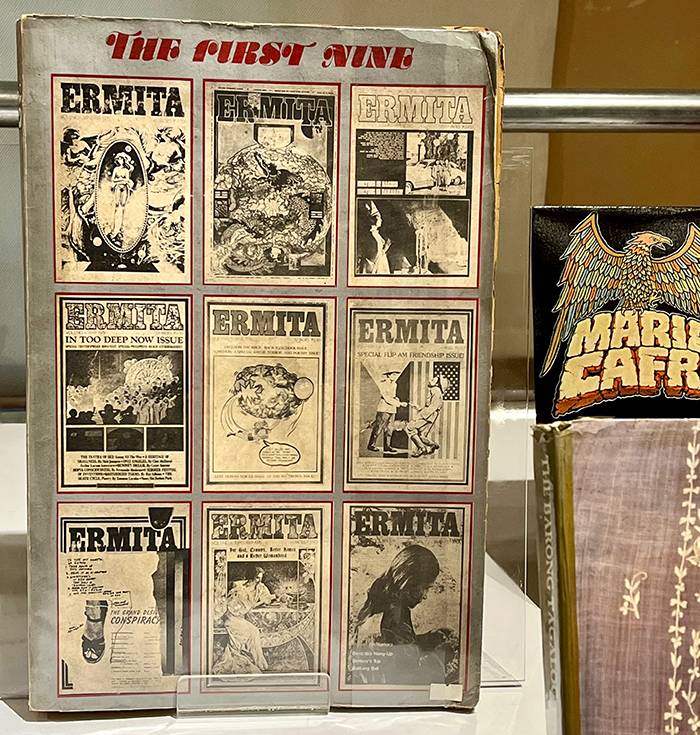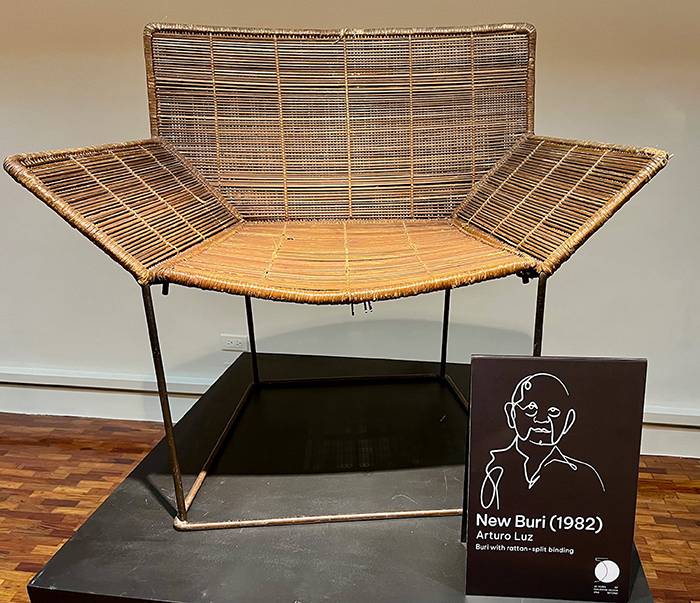Beyond 50 years of Philippine design
It was several Thursdays ago when like-minded neighbors agreed for us to brave the traffic from Ortigas Center to the heart of Manila. We had been tipped off on an exhibit at the National Museum of Fine Arts—the Design Center of the Philippines’ “50 Years of Philippine Design and Beyond,” which opened mid-December.
To our surprise, our early afternoon jaunt on an off-day was shared with similar resolve by hundreds of uniformed students who kept flocking to the venue. Of course their primary goal was to lay eyes, likely for the first time, on the storied “Spoliarium.” Their next focus of interest was Carlos “Botong” Francisco’s mural panels depicting Manila’s history at the former Senate Hall.
But a good number also took in the other permanent exhibits of vintage artworks in various halls, until they found themselves on the fourth floor where the temporary exhibit we came for was laid out, starting at the mezzanine balcony right above Botong’s restored masterwork.
From that balcony, the entire exhibit also takes up Galleries 25 and 26, with lines on the floor guiding viewers through these three areas where about 150 items are grouped together by way of a timeline.
For its golden anniversary, the Design Center couldn’t have assigned the exhibit’s curatorship to anyone other than premier museum curator Marian Pastor Torres, who characteristically enwraps all her projects with passion and knowledgeability.
This becomes quickly evident with the introductory text panels that provide an overview of the exhibit’s defining elements.
Of the first phase titled “1973 to 2000,” it is written: “The field of design picked up momentum towards becoming an integrated set of practices straddling artistry, commerce and trade, technology, and traditional research in the 1970s. That Design Center of the Philippines was also established in this pivotal historical moment suggests an interconnected dynamics. As massive cultural change broke out globally— transitioning Modernity into its denouement—the Design Center and the designer/manufacturer communities took the period instabilities as opportunities for pioneering work.
“Staged to coincide with the 50th anniversary of the Design Center of the Philippines, this exhibition nevertheless encompasses the greater context in which designers worked in the Philippines—whether in reaction to stimuli from the Design Center or entirely independent from this agency’s initiatives.
“… The word ‘design’ found wide application, encompassing graphics, furniture, gifts and houseware, interiors, film and theater production, architecture, fashion, comics, advertising and image-making, photography—with multiple overlaps with the world designated as art.”

Among the introductory items on that mezzanine, personally heartwarming was the happy inclusion of “Ermita—Compilation in one volume of the first nine issues of the magazine bannered as The Filipino Culture Magazine 1976 (January to October)”—with myself tagged as editor, Robert “Boy” Yñiguez as designer, and Alfonso “Boy” Yuchengco as publisher.
Sharing the display table were Visitacion de la Torre’s book The Barong Tagalog, a Maria Cafra music vinyl slipcase, and a 1972 set of “Salpakan (Game of the Generals)” from MindMasters, Inc., with Softonio H. Pasola, Jr. as game designer. Close by was photographer Wig Tysman’s framed portrait of Joey “Pepe” Smith titled “Rockstar,” dated 1984.
Adjacent display areas had Philippine Ancestral Houses by Fernando Zialcita and Martin Tinio (1980); GCF coffee-table books Turn of the Century (1978) and History of the Burgis (1987), both with art direction by Nic Ricio; Ikabod Let’s Makibaka by Severino “Nonoy” Marcelo (1987); a Himig ng Lahi vinyl slipcase (1987); and Pugad Baboy 1 by Pol Medina (1997). Just as interesting were the 1997 Ecobags from the women of KILUS Foundation, identified as “Appliqué, weaving” in various sizes, using “Discarded flexible foil pouch (Doypack) and synthetic textiles.” There too was the landmark “04 Untitled” from the Baro’t Saya series by Neal Oshima, C. 1998 to 1999, as “Photogram, printing / Etching paper.”
The text panel on “2001 to 2023” stated, in part:
“The first quarter of the 21st century for Filipino designers was the historical juncture when their work had to begin comprehending sustainability, limited raw materials and dangerous processes, and ‘Filipino’ or ‘Philippine’ meant seeking great understanding of social problems and geopolitical dynamics.
“… As technological change in the direction of digital media fed into the design process, Filipino designers maintained a parallel effort for greater understanding of indigenous traditions and plant life.
“… Through these developments, the Design Center pushed design as economic driver for the country, through continuous innovation of forms, processes, and materials.”

Here, what I found most attractive were the following: 2002 Bottle label & packaging by Olive Enriquez, from Capistrano Distillery (for a Philippine Lambanog bottle); also Don Papa Rum and other bottles, from 2012 up, with design by Stranger & Stranger, from Bleeding Heart Rum Company; the 2005 “Pepe apparel & lightbox” from Team Manila; 2006 “Orbit” with Wataru Sakuma design incorporating Pulp drawing / Mulberry fiber, from MASEACO; the Miss Philippines 2015 Pia Wurtzbach’s gown when she won the Miss Universe title; 2015 Auro Chocolate packaging, Mark Ocampo design; 2017 Theo & Philo Artisan Chocolates packaging, design by Dan Matutina, Roxanne Maniquiz and Craig Halili; 2019 “Bambino Bolt” from Bambike (with bamboo for the bicycle’s body); 2020 Maquette of the Bangkota Pavilion, Royal Pineda + Architecture & Design for Sculpting (diorama); 2021 illustration of “Tumindig” by Kevin Eric Raymundo, also known as Tarantadong Kalbo; 2023 “Melting Sacred Heart with Daggers” for sculpting and painting, with design by Leeroy New; and the 2023 “Paradise, WTF are you?” of recycled textiles, from Touch of Crafts.

I can’t recall now if the last was part of the 50 art chairs assembled in a hall, as inspired by “New Buri (1982)” by Arturo Luz, using Buri with rattan-split binding. But one of the most arresting of these was “Fantasy Loveseat” of 1988, representing “Woodworking, gilding” from JB Woodcraft, Inc.
“The Future Today” sums it up:

“The end of 2023 offers a clear view of the future for design by Filipinos. High-profile designers are strategizing and realizing the construction of zero-waste systems; shaping their operations within circular economies that they themselves are helping build; and wholly abiding by sustainable development goals.
“… The collection of 2023 innovations on the 1982 chair designed by National Artist Arturo Luz, founding director of the Design Center, presented as annotations on the future, display the sheer joy of designing within the Philippine context.”
Indeed, the collection of chairs bodes well for this future, as exemplified by “Paradise, WTF are you?” with its tropical baroque splendor. That the budding genius Leeroy New easily merges design with art in his 2023 specimen also assures us that the future of Philippine design will “be sustained by this conception of the creative act.”
With free admission, the exhibit is open to the public until March 3.


